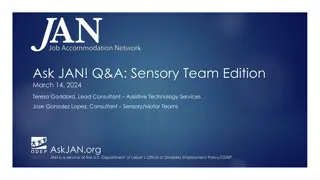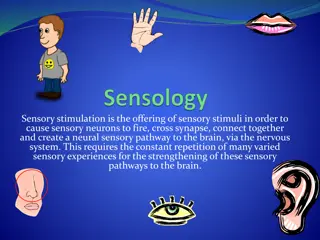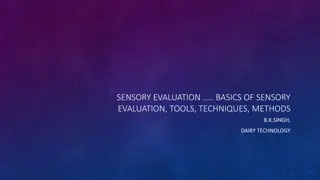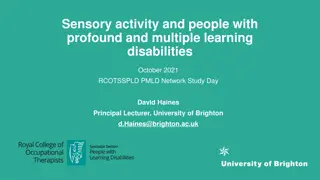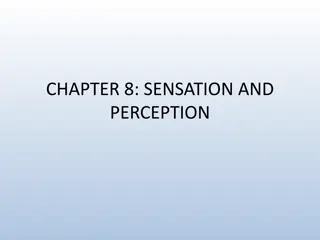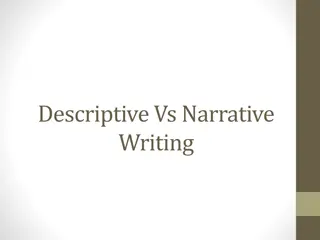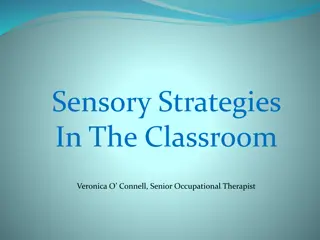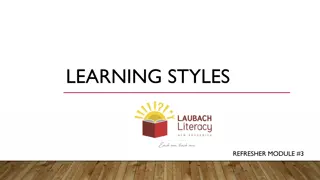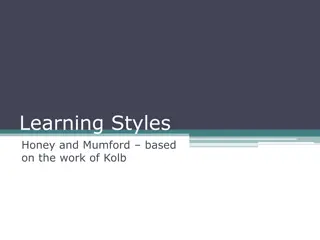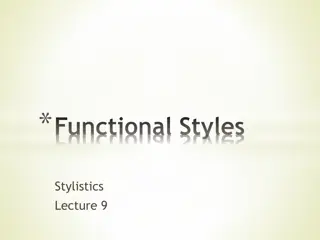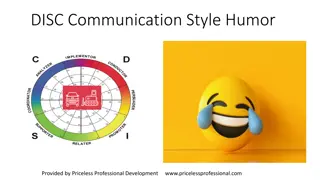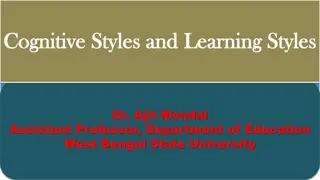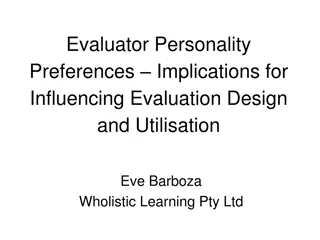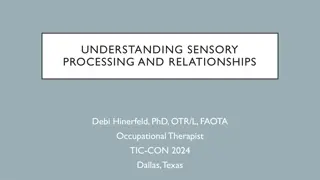Sensory Preferences in Learning Styles
Sensory preferences play a crucial role in learning styles, with individuals leaning towards visual, auditory, or kinesthetic ways of absorbing information. Discover how educators cater to these preferences to enhance learning experiences.
Download Presentation

Please find below an Image/Link to download the presentation.
The content on the website is provided AS IS for your information and personal use only. It may not be sold, licensed, or shared on other websites without obtaining consent from the author.If you encounter any issues during the download, it is possible that the publisher has removed the file from their server.
You are allowed to download the files provided on this website for personal or commercial use, subject to the condition that they are used lawfully. All files are the property of their respective owners.
The content on the website is provided AS IS for your information and personal use only. It may not be sold, licensed, or shared on other websites without obtaining consent from the author.
E N D
Presentation Transcript
VAK VISUAL : perceptible by the sense of sight; visible AUDITORY : resulting from the sense of hearing KINEASTHETIC: the sensation of movement or strain in muscles, tendons, and joints; muscle sense.
Now add up how many As, Bs and Cs you selected. A s = B s = C s =
If you chose mostly As you have a VISUAL learning style If you chose mostly B s you have an AUDITORY learning style If you chose mostly C s you have a KINAESTHETIC learning style
Using sensory preferences -Visual, Auditory, Kinaesthetic (VAK) The idea is that everyone has a primary or preferred way of taking in new information: whether by seeing it {visual), by listening to it (auditory) or by learning it through physical means - touch or movement {kinaesthetic).
Visual, Auditory, Kinaesthetic {VAK) preferences would suggest, for exam pie, that a learner who is primarily a visual learner would have more difficulty with a course that was presented through lectures {i.e. auditory).
This is what many teachers around the world now do, planning carefully to make sure that they include activities that appeal to V, A and/or K senses as appropriate.
English Language Teaching has always been fairly adventurous in methodology. A large number of ELT teachers offer varied, active, engaging, interactive lessons by defau It.
They often make use of visual, auditory and kinaesthetic activities. We would suggest that these teachers really do not need to worry too much about sensory preferences.
If you would like to experiment with using VAK in your teaching. You could: Do a VAK audit of your students. Devise teaching approaches that involve a mix of visual, auditory and kinaesthetic work. Observe how students respond to different sensory channels in your teaching.
Multiple Intelligences (Ml) Intelligence has traditionally been seen as an uncountable noun, something connected to academic and cognitive skills that you have more or less of, and which is indivisible.
Multiple Intelligences (Ml) Howard Gardner has proposed that it is more useful to think of humans as each having a number of distinct intelligences, present in varying degrees. His proposed list comprises
American cognitive psychologist and author, best known for his theory of multiple intelligences.
Multiple Intelligences (Ml) Linguistic Being good with words and language, reading and writing.
Multiple Intelligences (Ml) Logical/mathematical Being good with numbers, maths, logical processes, patterns, relationships between things and abstract concepts.
Multiple Intelligences (Ml) Spatial Being good with pictures, diagrams, maps and visual representations.
Multiple Intelligences (Ml) Bodily-kinaesthetic Being good with physical objects, dance, mime and acting. skills, sports, activities with tangible
Multiple Intelligences (Ml) Musical Being good with music, noticing sounds and recognizing tunes
Multiple Intelligences (Ml) Interpersonal Being good with other people; being good at communication and social skills.
Multiple Intelligences (Ml) Intrapersonal Being reflective and insightful about one's own psychology and internal life; being intuitive and self-confident.
Multiple Intelligences (Ml) Naturalistic Being good at recognizing and understanding aspects of the natural world around us, e.g. animals, birds, plants, looking after animals and pets, etc
Multiple Intelligences (Ml) Gardner's proposed list is not intended to be complete or definitive. As with VAK , MI has been widely picked up and applied in school environments. Many teachers feel an intuitive/emotional truth here and find that thinking about students' different intelligences helps them plan and teach. As with VAK, you can prepare lessons that deliberately set out to appeal to a wider range of intelligences.
Audits The audit is the key tool for finding out about your students' learner styles.
Here are some sample audit questions for determining VAK preferences: 1. Do you prefer to listen to the teacher explaining grammar or to read about it in a book? {i.e. auditory versus visual) 2. When you want to learn vocabulary, do you prefer to say the word again and again in your head or imagine the word written down on a page? (i.e. auditory versus visual)
3. When you listen to different syllable patterns in words, would you prefer to pick out the correct diagram of the pattern from a printed selection or arrange colored bricks of different sizes on the table to show the pattern. {i.e. visual versus kinaesthetic)
4. Do you prefer to stand up and role play/act a new dialogue or listen to someone else reading it aloud? (i.e. kinaesthetic versus auditory)
Here are some sample yes I no audit questions for recognising multiple intelligences: Do you like to do word puzzles and word games? Do you enjoy singing? Do you fairly regularly write a diary, journal or blog? Are you good at doing simple math problems in your head?
Bear in mind that the answers to individual questions may not reveal very much -and if you only use a few questions, they may give contradictory information.






